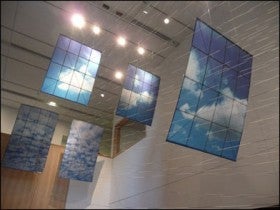Work of Boulder art faculty showcased at new museum
Melanie Walker's "Pieces of the Sky" (2011), a mixed-media installation, is part of the Faculty Art Exhibition at the CU Art Museum on the Boulder campus.
Image courtesy of the artist. (c) Melanie WalkerMelanie Walker's "Pieces of the Sky" (2011), a mixed-media installation, is part of the Faculty Art Exhibition at the CU Art Museum on the Boulder campus.
By Kristen Chapman
The University of Colorado Boulder Art Museum is hosting the largest faculty art exhibition in CU history. Covering more than 6,000 square feet,the show features 22 works, each by a different member of the departments of art and art history.
"This exhibition allows the campus and broader community an opportunity to experience and enjoy the dynamic artistic accomplishments of a faculty that comprises one of the largest art programs in the West," said Lisa Tamiris Becker, director of the museum. "It highlights the breadth and range of conceptual and aesthetic approaches practiced in our art and art history departments."
The works of art encompass a wide variety of media, making use of digital print, media installations, sculpture, paint and ceramics. The exhibit continues through March 11.
| IF YOU GO... |
| CU-Boulder Faculty Art Exhibition
When: Through March 11 |
This is the first faculty exhibition since 2007. Because two-thirds of exhibit visitors are students, the production is purposely timed for once every four years. The tradition began by displaying pieces of art along hallways in buildings throughout the campus, eventually growing into the current central show.
It's the first faculty show in the new Visual Arts Complex, which opened in September. Another first: Art Director Lisa Becker met individually with artists to oversee the installation of each piece. Becker aimed to highlight the importance of the artists within the community.
"Many of the works in the exhibition were created especially for this exhibition or are premiering in the exhibition," Becker said. "Other works may have been exhibited elsewhere, but did not receive extensive exposure in our area and thus are being presented in the exhibition to a new audience."
Among the highlights is Albert Chong's "Throne for the Third Millennium," an interactive installation inviting visitors to take a seat; they're surprised by the flapping of large mechanical wings attached to the chair.
Said Becker, "The artist was interested in the idea that there is a human desire for everyone to experience the sense of elevation that, in colonial times, would only be bestowed upon certain groups of people."
Jeanne Quinn's "A Thousand Tiny Deaths" is a ceramic display in which black porcelain elements are suspended from the ceiling by inflated balloons. Once the balloons are no longer able to support the structure, the ceramic vase falls to the floor and shatters.
"The piece references the fragility of the human experience and the fragility of life itself," Becker said.
The CU Art Museum was founded in 1939 when the university established a permanent collection.


